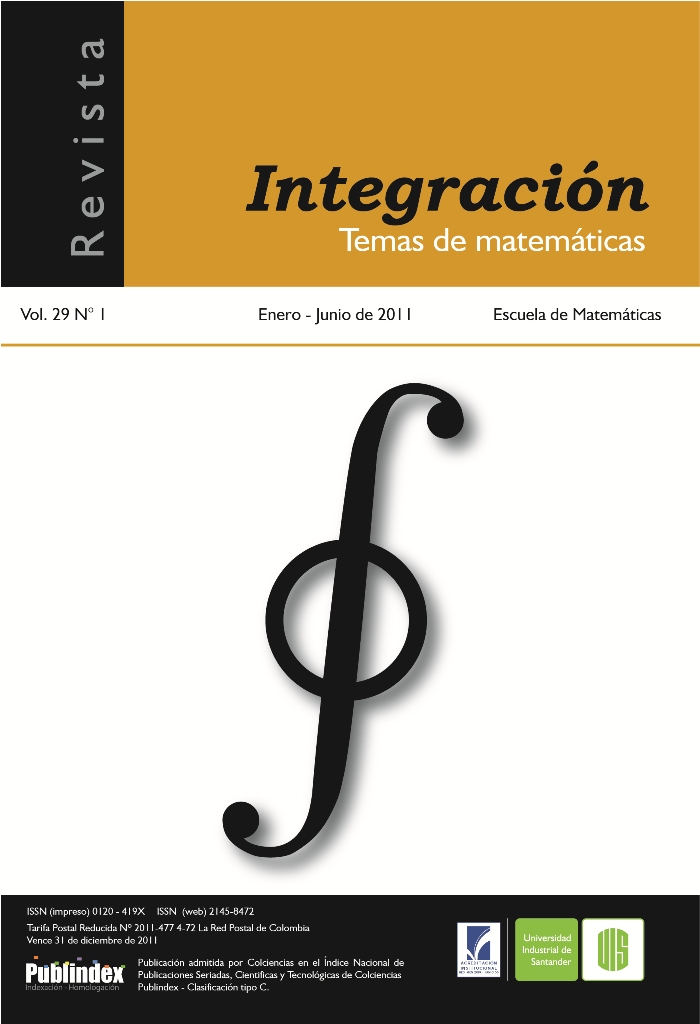Publicado 2011-01-31
Palabras clave
- Relatividad general,
- soluciones exactas,
- ecuaciones de movimiento
Cómo citar
Resumen
En este trabajo se presenta un estudio de las geodésicas temporales y nulas en el disco delgado relativista y newtoniano de Bonnor-Sackfield. Se analiza el movimiento de las partículas de prueba en el plano ecuatorial,tanto para el modelo newtoniano del disco delgado como para el disco relativista correspondiente. La naturaleza de las órbitas posibles se estudia por medio de un análisis cualitativo del potencial efectivo, y numéricamente mediante la solución de la ecuación de movimiento de las trayectorias ecuatorial radial y no radial: Se analiza la existencia de órbitas estables, circulares inestables y estables marginalmente, tanto para el caso newtoniano, como el relativista. Se presentan ejemplos de los resultados numéricos obtenidos con algunos valores de los parámetros simples.
Descargas
Referencias
[2] Bi˘cák J. and Ledvinka T., “Relativistic disks as sources of the Kerr metric”, Phys. Rev. Lett. 71 (1993), no. 11, 1669–1672.
[3] Bi˘cák J., Lynden-Bell D. and Katz J., “Relativistic disks as sources of static vacuum spacetimes”, Phys. Rev. D 47 (1993), 4334–4343.
[4] Bi˘cák J., Lynden-Bell D. and Pichon C., “Relativistic discs and flat galaxy models”, Monthly Notice Roy Astronom. Soc. 265 (1993), no. 1, 126–144.
[5] Bonnor W.A. and Sackfield A., “The interpretation of some spheroidal metrics”, Comm. Math. Phys. 8 (1968), no. 4, 338–344.
[6] D’Afonseca L.A., Letelier P.S., and Oliveira S.R., “Geodesics around Weyl-Bach’s ring solution”, Class. Quantum Grav. 22 (2005), no. 17, 3803–3814.
[7] González G. and Espitia O.A., “Relativistic static thin disks: The counterrotating model”, Phys. Rev. D 68 (2003), no. 10, 104028-1 – 104028-8.
[8] González G. and Letelier P.S., “Rotating relativistic thin disks”, Phys. Rev. D 62 (2000), 064025-1 – 064025-8.
[9] González G. and Letelier P.S., “Relativistic static thin discs with radial stress support”, Class. Quantum Grav. 16 (1999), no. 2, 479–494.
[10] Kramer D., Stephani H., Herlt E. and McCallum M., Exact Solutions of Einsteins’s Field Equations, Cambridge University Press, Cambridge-England, 2000
[11] Lemos J.P.S., “Self-similar relativistic discs with pressure”, Class. Quantum Grav. 6 (1989), no. 9, 1219–1230.
[12] Lemos J.P.S. and Letelier P.S., “Superposition of Morgan and Morgan discs with a Schwarzschild black hole”, Class. Quantum Grav. 10 (1993), no. 6, L75–L78.
[13] Lemos J.P.S. and Letelier P.S., “Exact general relativistic thin disks around black holes”, Phys. Rev. D 49 (1994), 5135–5143.
[14] Lemos J.P.S. and Letelier P.S., “Two families of exact disks with a central black hole”, Int. J. Modern Phys. D 5 (1996), no. 1, 53–63.
[15] Letelier P.S. and Oliveira S.R., “Exact selfgravitating disks and rings: a solitonic approach”, J. Math. Phys. 28 (1987), no. 1, 165–170.
[16] Lynden-Bell D. and Pineault S., “Relativistic disks - 1. Counter rotating disks”, Monthly Notice Roy Astronom. Soc. 185 (1978), 679–694.
[17] Lynden-Bell D. and Pineault S., “Relativistic disks - 11. Self-similar disks in rotation”, Monthly Notice Roy Astronom. Soc. 185 (1978), 695–712.
[18] Morgan T. and Morgan L., “The Gravitational Field of a Disk”, Phys. Rev. 183 (1969), 1097–1101.
[19] Morgan L. and Morgan T., “Gravitational Field of Shells and Disks in General Relativity”, Phys. Rev. D 2 (1970), 2756–2761.
[20] Morse P.M. and Feshbach H., Methods of Theoretical Physics, McGraw-Hill, New York, 1953.
[21] Semerák O., “Gravitating discs around a Schwarzschild black hole. III”, Class. Quantum Grav. 20 (2003), no. 9, 1613–1634.
[22] Semerák O. and Zá˘cek M., “Oscillations of static discs around Schwarzsch ˘ ild black holes: Effect of self-gravitation”, Publ. Astron. Soc. Japan 52 (2000), 1067–1074.
[23] Semerák O., Zá˘cek M. and Zellerin T., “The structure of superposed Weyl ˘ fields”, Monthly Notice Roy Astronom. Soc. 308 (1999), 691–704.
[24] Voorhees B.H., “Static Axially Symmetric Gravitational Fields”, Phys. Rev. D 2 (1970), 2119–2122.
[25] Weyl H., “Ausbreitung elektromagnetischer Wellen über einem ebenen Leiter”, Ann. Physik 54 (1917), 117–145.
[26] Weyl H., “Bemerkung über die axialsymmetrischen Lösungen der Einsteinschen Gravitationsgleichungen”, Ann. Physik 59 (1919), 185–189.
[27] Zipoy D.M., “Topology of Some Spheroidal Metrics”, J. Math. Phys. 7 (1966), 1137–1143
